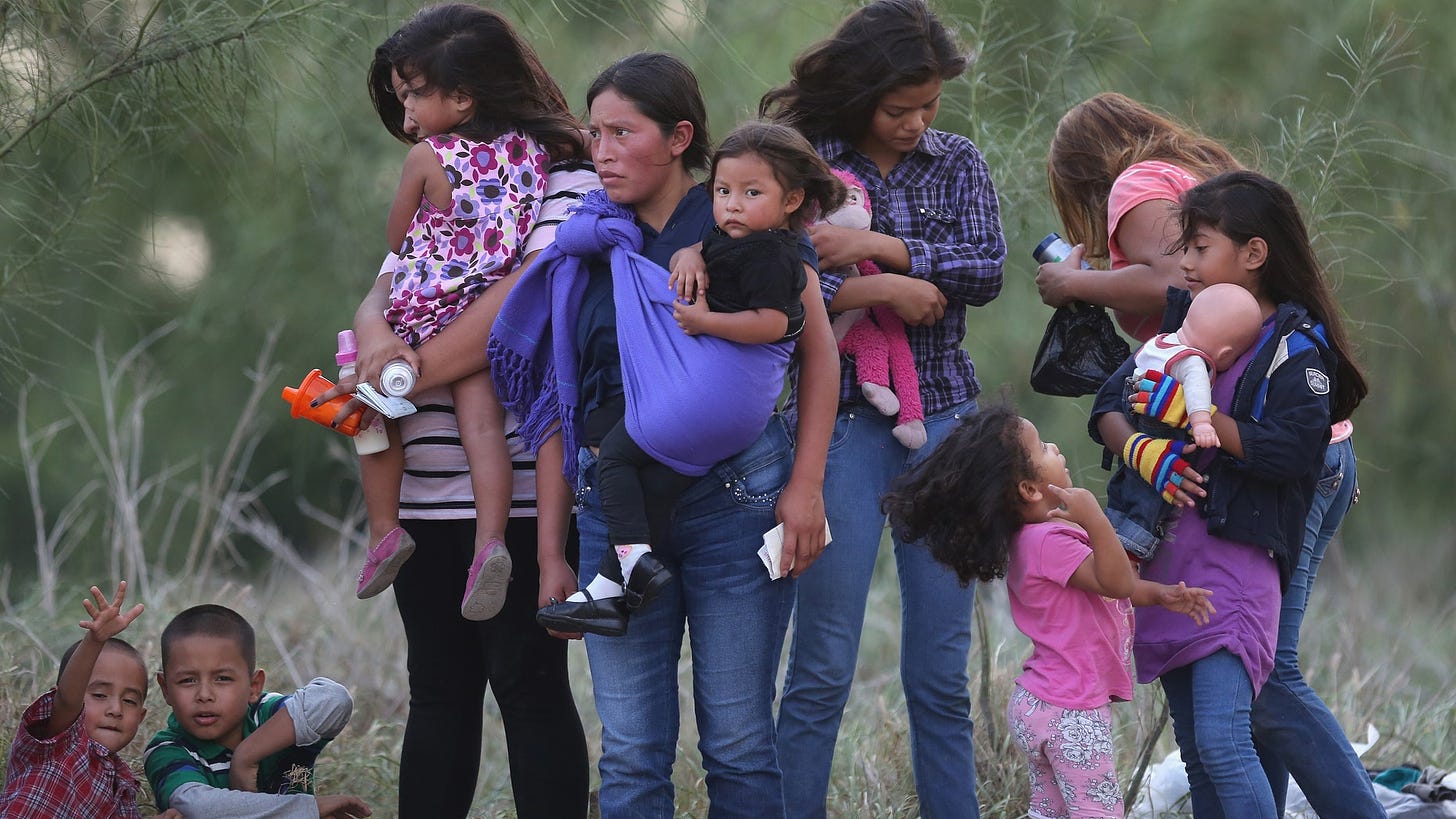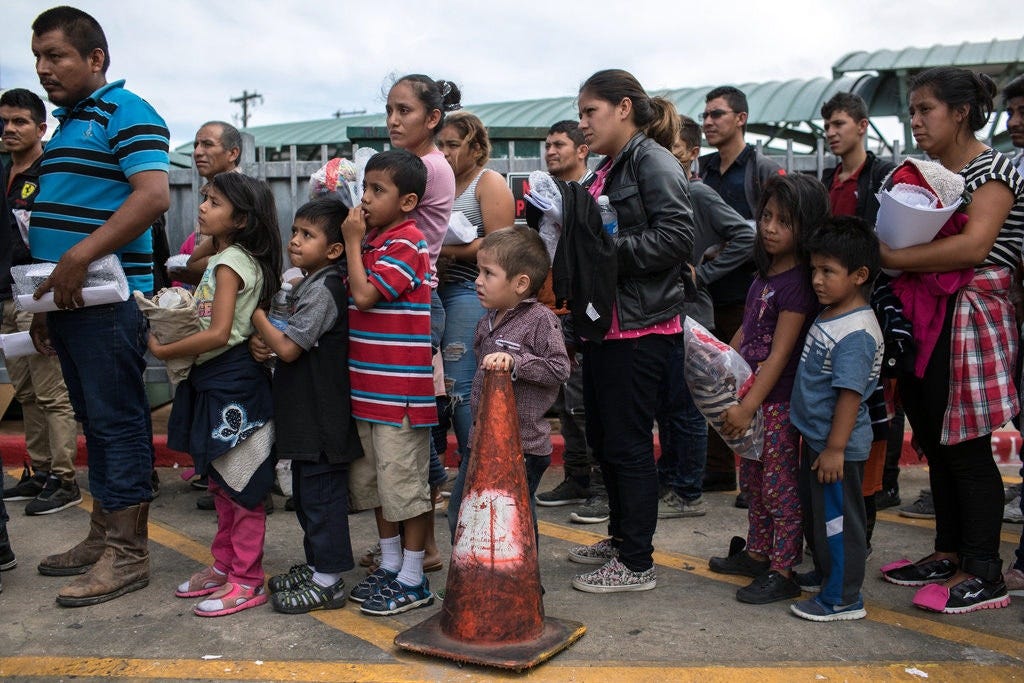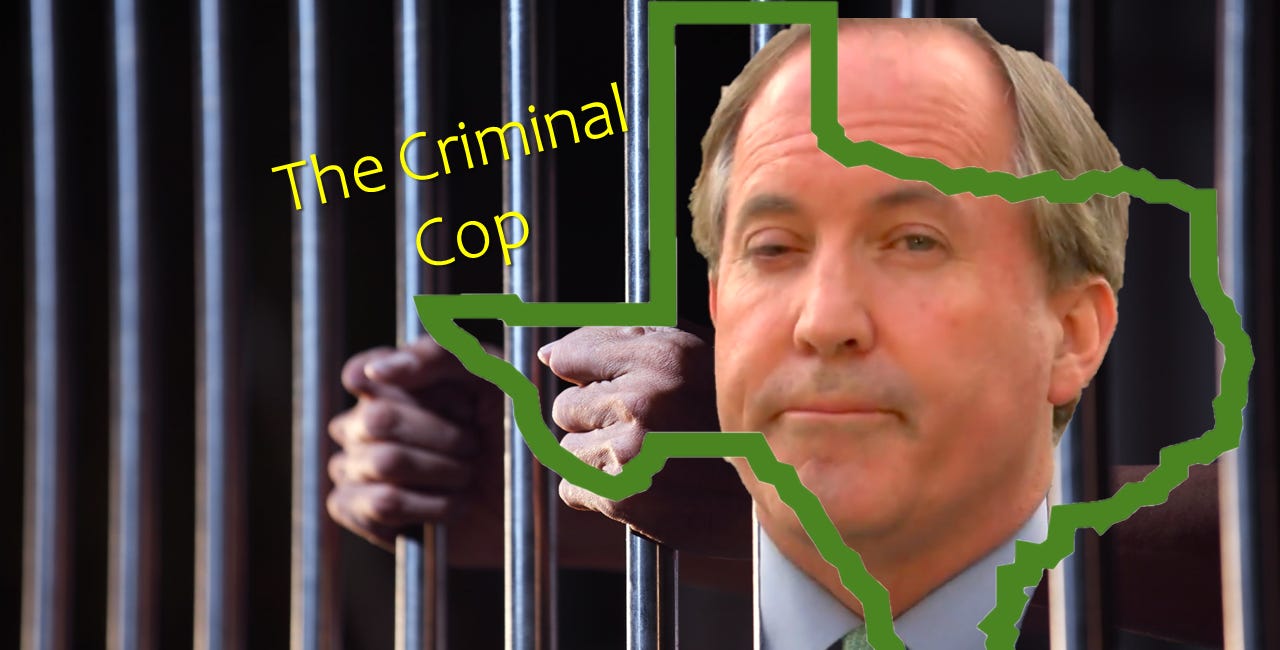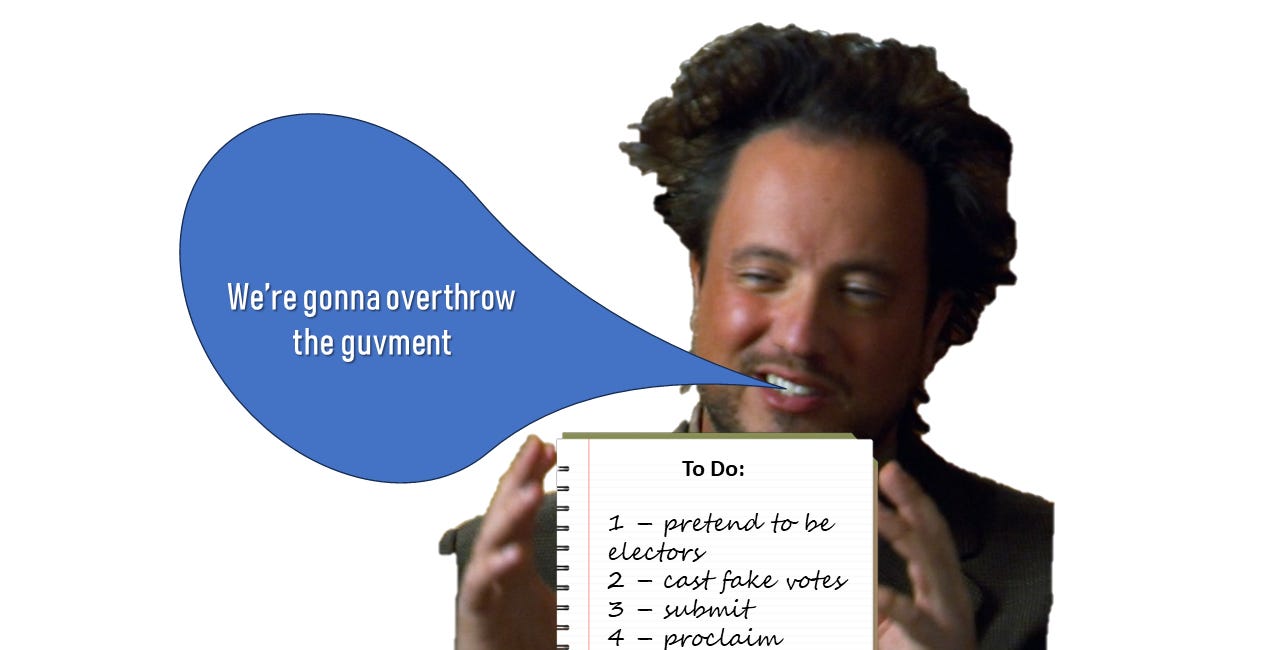A Bastion of Freedom and Opportunity--for the 'right' folks
It is time to shut down anti-immigrant driven atrocities
Visit the Evidence Files Facebook and YouTube pages, which includes the latest podcast episode; Like, Follow, Subscribe or Share!
Far too many Americans hold despicable views on immigration, despite the fact that practically all of them are Americans by the very virtue of their immigrant ancestors. Immigration policy in the U.S. has long favored the “right” people and characterized the rest as “illy adapted,” or let’s just say, of the wrong ethnicity or nationality. A substantial piece of the Republican party has minced no words about the basis of their beliefs. Donald Trump, the ostensible leader of that party, the former president, adjudged rapist, and multiply indicted likely criminal, said this about immigrants without evidence:
No control whatsoever, nobody has any idea where these people are coming from, and we know they come from prisons, we know they come from mental institutions, insane asylums, we know they're terrorists… It's poisoning the blood of our country, it's so bad and people are coming in with disease, people are coming in with every possible thing that you can have...
He’s talking about these people. Source: Fox News
This type of commentary is reflected in the broader “great replacement theory,” something pundits like former Fox commentor Tucker Carlson has promoted hundreds of times. The crux of this lunatic theory is that Democrats seeks to “replace” white voters with, well… non-white ones, to win elections. Professor Matthew Feldman, a writer and specialist on rightwing extremism, said this of the idea:
One, we might call it ‘great replacement lite’, is saying: There’s a huge demographic shift and these people tend to vote Democrat in the US or Labour in the UK… [He describes the ‘fat’ version as follows]: This is a conspiracy organised by elites – they’re deliberately undermining white majorities. Both of them are, in a sense, conspiracy theories, saying this isn’t just patterns of immigration and demographic change, but this is being engineered. But who is engineering it, and for what, is something the further fringes of the far right are all too keen to speculate on.
Brian Hughes, associate director of the Polarization and Extremism Research and Innovation Lab, while discussing statements by Ohio Senator JD Vance [R], Arizona Republican Senator wannabe Blake Masters [he lost], and Eric Schmitt, the former state attorney general and now senator of Missouri [R], described their comments this way:
They predict racial doomsday, saying that it is all part of an orchestrated master plan. It’s only the language that has been softened. The basic story they tell is the same one we see in white supremacist chats across the internet: An enemy is orchestrating doom for white Americans by plotting to fill the country with nonwhites.
This incendiary language and ideology has striking parallels to other regimes who gained power and were later obliterated for the evils they committed under it. Others avoid openly claiming that anti-immigrant views are based on race or ethnicity—though they clearly are. Instead, their mantra is characterized as “skilled” versus “unskilled.” But, it is not as clever as they think. Perennially contemptible Tom Cotton, a senator from Arkansas, explained it:
[W]hen only 1 out of every 15 immigrants arrives in the United States on a skills-based visa, the majority of the remaining immigrants are either low-skill or unskilled… This generation-long influx of low-skilled labor has been a major factor in the downward pressure on the wages of working Americans… This collapse in wages threatens to create a near permanent underclass for whom the American Dream is always just out of reach.
He is, of course, wrong. Ample research shows that immigration is largely a net positive for the country. One study showed that “immigrants make up roughly 15% of workers in the U.S., yet they are 80% more likely than native workers to become entrepreneurs.” Another study concluded that:
Shifting the mix of legal immigrants toward college graduates would have little impact on employment and slightly increase GDP; legalization of undocumented workers would slightly reduce employment and have a negligible impact on GDP; increasing deportations would substantially reduce both employment and GDP; and the largest positive impact on employment and GDP would come from increasing the net flow of immigrants [emphasis added].
Still another found that “among startup companies that were valued at more than $1 billion in 2016, half were founded by immigrants. Among Fortune 500 companies, 40 percent were founded by immigrants or their children.” And there are plenty more analyses making similar findings. Cotton’s voting record reveals that his professed concerns about wages is a blatant lie. Here is that voting record:
Senator Cotton opposes: 1) taxing businesses, 2) restricting money in politics, 3) consumer protection, 4) disaster relief, 5) funding education, 6) financial sector regulation, 7) labor rights and wages, 8) avoiding default, 9) taxing the wealthy, 10) a robust safety net;
Tom Cotton supports: 1) big business, 2) taxing the middle class.
Holding contempt for Cotton’s stated motivation behind restricting immigrants of certain “skill levels” is definitely warranted. Unfortunately, Cotton’s thinly veiled racism is driven by a view shared by a great number of people. It has led to the demonization of human beings based on specious (if any) reasoning, unsupported by facts. Worse, in adopting this dehumanizing ideology, people who might otherwise be morally decent seem perfectly content to allow public authorities to take actions that can only be classified as morally repugnant. Cruelty is fine if it is directed against those they can allow themselves to view as “criminals,” “terrorists,” or “poison.” Officials engage in vile behavior driven by this impotent ideology in the name of the United States, the supposed bastion of freedom and opportunity. You can hear their hypocrisy in their own words.
Some, however, have taken it way beyond mere words. When policies built on cruelty lead to grossly abusive action, the law needs to step in. It should start with the state of Texas.
The next sections of this article is based on publicly known information. A thorough investigation would almost certainly uncover far more damning evidence. Some may argue with the legal theories proposed below based on the currently available information, but an in-depth investigation with these charges in mind, conducted by objective investigators, would probably provide ample support for these charges, others like them, or ones not even contemplated here.
Manslaughter
A few days ago, three people attempting to cross the Rio Grande River from Mexico into the USA drowned—a mother and her two children. They might have been saved, but for the Texas Military Department and the Texas National Guard. According to U.S. Representative Henry Cuellar:
[A]round 9 the night before… U.S. Border Patrol agents contacted state National Guard officials deployed to the region as part of Abbott's Operation Lone Star near the Shelby Park entrance but were told that even in an emergency, the federal agents would not be allowed to enter the park.
As a result, the three received no aid and subsequently died. The incident came on the heels of the forcible takeover of an adjacent park by state authorities on command of Governor Greg Abbott. No official reason was given for the takeover, and it was met with disapproval by local mayors—and may be illegal. Armed National Guard soldiers and Texas Department of Public Safety troopers currently patrol the now fenced-in area. The governor’s spokesperson offered this specious reasoning:
Texas is holding the line at our southern border with miles of additional razor wire and anti-climb barriers to deter and repel the record-high levels of illegal immigration invited by President Biden's reckless open border policies.
A local group called Border Vigil Eagle Pass called out this statement as a lie:
The Governor's action comes at a time when the number of unauthorized crossings at Eagle Pass has dropped precipitously, thanks to the extensive measures taken by the Mexican government, the state of Coahuila, and the city of Piedras Negras to prevent and deter irregular migration.
Whether the number of migrants crossing the border is “record breaking” or not (and it is unclear that it is), that does not obviate responsibility for killing people by preventing their rescue—migrant or not.
Texas law criminalizes reckless or negligent homicide. The Supreme Court of Texas has found as a critical element of either of these that the defendant “ought to have been aware [or was aware] of the substantial and unjustifiable risk created by [its] conduct.” In finding that the state proved a woman guilty of negligent homicide, the court said this:
[T]he state had no burden to show that driving while using a cell phone is always risky or dangerous, or that it, of itself, creates a substantial and unjustifiable risk, only that appellant's use of a cell phone in this case created a substantial and unjustifiable risk because it interfered with her ability to maintain a proper lookout for other vehicles…
[T]he jury could have reasonably found that appellant's failure to appreciate the substantial and unjustifiable risk, given the circumstances known to her at that time, was a gross deviation from a standard of care that an ordinary person would exercise under the same circumstances.
For negligent homicide, the Texas Court of Appeals articulated the necessary elements:
(1) the defendant's conduct caused an individual's death;
(2) the defendant ought to have been aware that there was a substantial and unjustifiable risk of death from [defendant’s] conduct; and
(3) the defendant's failure to perceive the risk constituted a gross deviation from the standard of care that an ordinary person would have exercised under like circumstances.
The Southern District Court of Texas (SDTX) noted that under Texas law:
The key to criminal negligence is not the actor's being aware of a substantial risk and disregarding it, but rather it is the failure of the actor to perceive the risk at all… the difference between criminally negligent homicide and manslaughter is the culpable mental state of criminal negligence for the former and recklessness for the latter.
The reported facts in the case of the drowned family seem to meet the threshold for elements 2 and 3 of negligent homicide or, more likely, recklessness (manslaughter). The Texas Court of Appeals described “reckless” this way:
A person acts recklessly, or is reckless, with respect to circumstances surrounding his conduct or the result of his conduct when he is aware of but consciously disregards a substantial and unjustifiable risk that the circumstances exist or the result will occur... Manslaughter is a "result of conduct crime," one in which recklessness must go to the conduct causing the death.
In other words, the difference lies only in whether the defendant perceived the risk or not. Failure to perceive means negligence; perceiving the risk and ignoring it is recklessness. On the mental element, the Texas troopers clearly perceived the risk—the federal agency advised them of it. Moreover, previous agreements over the border wire Texas erected in the river acknowledged that both state and federal officials recognized the potential risks. Texas authorities and the Customs and Border Patrol (CBP) together confirmed that “the c[oncertina] wire must be cut in the event of an emergency, such as the threat of a migrant’s drowning or suffering heat exhaustion.” That agreement provides unambiguous evidence that both the feds and state agents were aware of the potential risks. Even if Texas authorities successfully argue they still did not perceive the risk, they ought to have. Determining whether a defendant perceived the risk is a question for a jury.
[M]ental culpability is of such a nature that it generally must be inferred from the circumstances under which a prohibited act or omission occurs." The Court of Criminal Appeals has explained that the defendant's state of mind is a question of fact that must be determined by the jury, and in doing so the jury may infer the culpable mental state from any facts in evidence which tend to prove its existence.
Texas troopers blocking federal agents from conducting a rescue created a substantial and unjustifiable risk that the migrants would die, especially given that the federal agents informed them of the the migrants’ distress. The woman in the cellphone case mentioned above knew, according to that court, that using her phone while driving at highway speed comprised a “gross deviation” from how an ordinary person would have acted. Informing a police agency of a family in distress at least warranted a search for those people, particularly when advised by another law enforcement agency. Acting to prevent the federal agents from conducting any kind of rescue operation was gross deviation from how an ordinary person would—or should—have acted, thereby constituting recklessness.
The remaining question is whether that conduct “caused” the family’s death.
Proving charges under the manslaughter or criminally negligent homicide statutes that the troopers caused the death of the family may be difficult. Judicial precedent seems to suggest that the causal factor must be the direct contribution to the victim’s death, such as hitting them with a car or shooting them with a gun. It does not appear likely that such an element could be proved in this case with the evidence provided so far. Causing death by omissions or acts that themselves did not constitute the imminent causation, however, is a crime in Texas when it comes to children.
Texas law section 22.04—Injury to a Child—makes it a felony criminal offense to cause injury or death to a child (see also, Texas penal code ann. § 1.07(46) if the defendant acted “with criminal negligence, by act or intentionally, knowingly, or recklessly by omission” [emphasis added] that resulted in serious injury or death. In Williams v. State, the Texas Court of Appeals provided some examples:
letting a 350-pound lion, which was neither muzzled nor declawed, out of its cage at a flea market populated by children;
speeding and running through stop signs with a child passenger;
failing to report to the authorities that [defendant’s] boyfriend had violently kidnaped [her children];
failing to immediately seek medical help for a lethargic child;
and leaving four-year-old twins unsupervised and wandering around an apartment complex.
The court stated that such examples "resemble[] acting knowingly in that a state of awareness is involved, but the awareness is of risk, that is of a probability less than substantial certainty.” And, more importantly,
A person responsible for such "conscious risk creation" that results in serious bodily injury to a child is "criminally responsible if the result would not have occurred but for his conduct, operating either alone or concurrently with another cause, unless the concurrent cause was clearly sufficient to produce the result and the conduct of the actor clearly insufficient.”
For acts of omission, courts generally require the defendant to have 1) a legal or statutory duty to act; or 2) has assumed care, custody, or control of a child. In Proo v. State, the court determined that “No familial relationship with the child is necessary for a duty to act to arise” nor does defendant need to have assumed exclusive “‘care, custody, or control’ of the child, as multiple persons may each have an individual duty to act on behalf of the child.” The court noted that it found sufficient custodial control in a case where the defendant “regulated the child's food consumption, medical attention, and movement” during even limited periods. Furthermore, the Proo court stated that “causing the child's injury requires evidence that the defendant was aware with reasonable certainty that the result of serious bodily injury/death would have been prevented had the defendant performed the act that was omitted” [emphasis added]. It also intoned that prosecutors must “prove the child suffered the serious bodily injury because of the defendant's omission.” Some examples the court gave included being aware of a perilous medical condition of the child or that the child was in a dangerous environment that the defendant’s actions or inactions could have prevented. Even causing a delay in taking action to prevent the injury or death satisfies the element.
In Bleimeyer v. State, the court found that control over the child’s access to help (in the form of medical care) bestowed upon the defendant a duty of care. The court determined this based, in part, on the defendant’s affirmative act to prevent another person from taking the victim to a doctor. Prohibiting others from assisting the child in that case effectively imposed that duty on the defendant. The Texas troopers engaged in the same conduct.
The Court of Appeals in Durkovitz v. State did not consider the custodial element at all. There, the court upheld a conviction for the offense of recklessly causing serious bodily injury to a child when the defendant:
an experienced animal trainer, took his 350 pound grown lion to the Texas Flea Market in Houston on eight different occasions for the purpose of charging patrons to be photographed with the lion… although he was aware that the lion posed a significant danger for children because of it's [sic] predator instinct, and that many children were at the flea market, appellant nevertheless took the lion out of its cage into the flea market, attempting to control the lion by only a short, heavy chain… because the lion had become increasingly frisky and restless, appellant attempted to lead the lion through the main aisle to the front doors of the flea market, although it was still full of people, including many children. Appellant lost control of the lion, which grabbed the minor complainant and attempted to crush her head into its mouth.
The court identified 18 key pieces of evidence in support of upholding the conviction, none of which explicitly related to any individualized duty of care. Three of those pieces of evidence are directly relevant to the case here:
that the person who sold the lion to the appellant warned him of the dangers of taking the lion around children; [federal agents warned Texas troopers of the peril of the family]
that on the date of the attack, because of the carnival, appellant knew many children would be at the flea market; [Texas troopers knew of the inherent danger created by Texas’ erection of barriers and other dangerous obstacles] and
that instead of coming to the aid of the injured child, appellant cried and smashed a table with his fist and his assistant ran out of the flea market and disappeared [Texas troopers actively prevented others from engaging in a rescue].
In other words, the Durkovitz court decided that the defendant’s knowledge of the risk posed and his failure to come to the aid of the victim was sufficient to uphold the conviction. Those points are key to the behavior of the Texas troopers who engaged in parallel conduct.
Proo, Durkovitz, and Bleimeyer taken together suggest that the Texas troopers’ interference with the federal agents’ attempt to launch a rescue renders their conduct criminal under section 22.04. State authorities claim the family was already dead prior to the federal agents’ arrival at the walled-off park, but federal authorities respond that they had tried repeatedly to advise them of the situation. Fox News has reported the story of Texas authorities as true, citing a filing with the court in which the Department of Homeland Security (DHS) allegedly concedes it. Notably, Fox does not link to the supposed filing or provide an exact quote, nor could I find either, but the letter DHS sent to Texas authorities demanding they leave the park dated two days before the Fox article makes no such admission. In other words, according to the feds—who are far more credible here—the intentional obstruction by state authorities prevented them—or anyone—from conducting a rescue. At the least, an investigation is needed.
Again, we are talking about people like these. Source: NY Times
Deprivation of rights under color of law
Title 18 U.S. Code § 242 states:
Whoever, under color of any law, statute, ordinance, regulation, or custom, willfully subjects any person in any State, Territory, Commonwealth, Possession, or District to different punishments, pains, or penalties, on account of such person being an alien, or by reason of his color, or race, than are prescribed for the punishment of citizens, shall be fined under this title or imprisoned not more than one year, or both; and if death results from the acts committed in violation of this section… shall be fined under this title, or imprisoned for any term of years or for life, or both, or may be sentenced to death [emphasis added].
Last anyone looked, an unlawful trespass into this country is not punishable by death. Killing such trespassers out of callousness, commanded by a governor who has shown no hesitancy at breaking the law for political purposes, however, is. In 1966, the US Supreme Court in US v. Price described section 242 this way:
[T]he [lower] court… necessarily concluded that an offense under § 242 is properly stated by allegations of willful deprivation, under color of law, of life and liberty without due process of law. We agree. No other result would be permissible under the decisions of this Court. Screws v. United States, 325 U. S. 91;
In that case, the State of Mississippi instituted a program of “monstrous design” wherein its officers “participated in every phase of the alleged venture: the release from jail, the interception, assault and murder.” The officers, the Court continued, must “suffer the consequences” of their participation and that by engaging under the auspices of state police power, they were acting under color of law.
In 1980, the 9th Circuit Court of Appeals held that the statute protected anyone within the jurisdiction of the United States, whether “alien” or citizen. There seems little question that these three family members were in the jurisdiction of the United States, given that Mexican authorities alerted US federal agents of their plight. Amendments to the law after 1980 made Congress’s intent to protect such people even more clear. The only question here seems to be whether the State authorities’ efforts to hinder the rescue of the victims itself constituted an act that “subjects [a] person… to different punishments, pains, or penalties.”
In Screws v. United States, the Supreme Court discussed at great length what § 242 criminalizes:
For the specific intent required by the Act is an intent to deprive a person of a right which has been made specific either by the express terms of the Constitution or laws of the United States or by decisions interpreting them. Take the case of a local officer who persists in enforcing a type of ordinance which the Court has held invalid as violative of the guarantees of free speech or freedom of worship. Or a local official continues to select juries in a manner which flies in the teeth of decisions of the Court. If those acts are done willfully, how can the officer possibly claim that he had no fair warning that his acts were prohibited by the statute? He violates the statute not merely because he has a bad purpose but because he acts in defiance of announced rules of law… When they act willfully in the sense in which we use the word, they act in open defiance or in reckless disregard of a constitutional requirement which has been made specific and definite. When they are convicted for so acting, they are not punished for violating an unknowable something.
Texas authorities cannot deny their awareness of their violations of rights because they have persisted in engaging in them, courts have declared their activities illegal, and the media has extensively reported on it. Governor Abbott himself has stated he would prefer to kill migrants coming from Mexico, but has not given the order for fear of being charged with murder. He all but admitted, however, that he is ordering any other illegal activity up to but stopping only at that point:
The only thing that we're not doing, is we're not shooting people who come across the border because, of course, the Biden Administration would charge us with murder [emphasis added].
To be clear, the governor of Texas is bemoaning to the press that the only reason he can’t order the killing of migrants is because he would be charged with murder.
Back in July, the Houston Chronicle revealed accounts given by a Texas trooper to his superiors complaining of orders prohibiting them from giving water to migrants. The email also notes the inhumane effect of the illegally erected razor wire in the middle of the river, that seems to have been put there for maximum barbaric intent. The 5th Circuit stayed a lower federal judge’s order to remove the barrier, but this in no way indicates its legality. A stay is not a judgment but only a pause in the enforcement of an order while it is reviewed. That means that so far a federal judge has determined that the barrier is illegal, and no other judge has ruled otherwise.
Texas Department of Public Safety, Lt. Christopher Olivarez openly confessed that the various barriers erected by the state were meant to harm migrants. He told ABC News that the dangerousness of the barriers was the point, and “that the idea is to put these things in place to deter crossings.” Texas officials have not stopped their abuse there. Human Rights Watch notes that,
The [Texas border] policy has led to Texas law enforcement officials arresting migrants on false allegations of low-level trespassing violations or inducing migrants to step on private property, then arresting them. Those arrested have been imprisoned, in several cases in abusive conditions, for weeks or months without charges or access to attorneys. The vast majority of charges have ended up being dropped or dismissed. The operation has increased the state’s pretrial detention population, undermining criminal legal system reforms.
These assertions, if true, indicate that the state has instituted a policy of monstrous design, built upon violations of law and Constitutional principles, predicated on the racist notion that humans attempting to enter the United States are not afforded any lawful protections and thereby deserve whatever cruelty the state of Texas wishes to inflict upon them. Supporting this contention is the fact that only 3 percent of those charged with any crime have been convicted, and in all of those cases, the person had pleaded guilty. Numerous Congresspeople penned a letter to the Department of Homeland Security stating that “there have been delays of filing charges, delays in appointing attorneys for migrants, and migrants unknowingly filing out documents they could not read to waive their right to counsel.” Law enforcement knows this is all illegal activity.
In addition to their awareness of the wrongfulness of their actions, the Texas troopers have willfully and repeatedly acted with reckless disregard of migrants’ right to life. Courts have recognized the “state created danger theory,” wherein the government has a heightened duty to protect a person when it either created the danger or took actions rendering the person more vulnerable to the danger. According to the Michigan Court of Appeals, the theory applies when the government creates “a special danger to the [person] wherein the state's actions placed the [person] specifically at risk, as distinguished from a risk that affects the public at large; and the state knew or should have known that its actions specifically endangered the [person]. The 3rd Circuit Court of Appeals “recognized that municipalities may be held liable for establishing and maintaining a custom, practice, or policy that causes constitutional deprivations when that custom, practice, or policy was established or maintained with recklessness or deliberate indifference to the consequences.” Erecting razor wire and other barriers whose stated intent is to cause danger or harm cannot be characterized as anything but “state-created.”
The 7th Circuit proclaimed that, “When a state cuts off sources of private aid, it must provide replacement protection.” In Ross v. US, the 7th Circuit held that when police prevented private rescuers from saving a drowning person, they deprived that person of his 14th Amendment right to life. Furthermore, they were liable because they committed this depravation under the color of law. At the Texas border, the state has created a program of monstrous design, built upon purposeful and malicious state-created danger, and has actively sought to deprive people of their 14th Amendment right to life. This environment represents an abject defiance of the law and Constitution, and as a result, Texas officials and every participant beneath them are responsible for the death of at least three people, and the violations of the rights of innumerable others. The Department of Justice must act.
The US has a History of Putting Down this Kind of Resistance
The United States is no stranger to quasi-rebellions throughout its history. Many of these commenced on far more moral grounds than what is happening in Texas, and often did not involve violence until such time as federal authorities sought to remove the interlopers. Take, for example, what the US Marshal Service has called the “longest civil disorder” in US history, the occupation of Wounded Knee back in 1973. Journalist Kevin McKiernan of NPR wrote that the event was spurred by complaints of poverty and police brutality by Native Americans. NPR described McKiernan ‘s view of it as follows:
[The] image most people have of the occupation is one of violence and guns (of which there were plenty, with the government later admitting to firing some half a million rounds into the area). But he doesn't think that's the whole story… The real story… were the religious ceremonies that took place inside Wounded Knee. And this became a kind of laboratory for the hundreds who came there, in getting their religion back, learning some of their language, which led to a revival ... And these are two components of what [he saw as its] core identity, language and religion.
Despite the federal government mostly being in the wrong—later having admitted to breaking treaties and the Supreme Court ruling that the government owed the Sioux tribe money for illegally taking its land—it nonetheless descended upon the occupation with force, firing half a million rounds in its enforcement action. [The Marshals Service continues to claim this was in response to violent harassment initiated by the occupiers while those involved in the protest claim the opposite]. One man, Leonard Peltier, was tried and convicted for the death of two FBI agents during the violent exchange. Many hundreds more were arrested as a result.
FBI agents, armed with M16A2 assault rifles, position themselves in an armored personnel carrier and watch as AIM members escort an Iroquois delegation from Wound Knee after they met with American Indian Movement leaders. Photo by Bettmann Archive/Getty Images - From the Smithsonian Magazine
In 2016, a standoff hit the national news between ranchers living near the Malheur refuge and the federal government. The story is rather confusing as the occupiers of the federal land had mixed support from locals, but also recruited supportive members of militias from around the region. In any case, the event persisted for 41 days. At the end, the federal government indicted 26 people for various crimes such as conspiracy to impede federal employees from doing their work at the refuge through intimidation, threats or force, and other charges. Some people were arrested while the standoff continued, and federal judges refused to let them free until it ended.
In both cases, and many others, the federal government tolerated disruptions and occupations only briefly when those activities impeded the execution of federal functions. In nearly all of those cases, however, the occupiers were not engaged in harming other people like what is occurring in Texas. The strategy adopted in the Malheur incident provides a guideline for what the federal government should do now. Rather than provoke a violent confrontation with armed troopers, start indicting command level personnel, such as the Governor or commandants of the police agencies occupying Shelby Park. This essay outlined only a few charges that seem provable under only the available evidence. There are no doubt many more, such as obstruction-related crimes, interference with certain protective functions, other violations of civil rights, contempt, and so on.
The state of Texas is led by a man who literally told media he would shoot migrants but for the fact he knows he would be indicted. His attorney general—the highest law enforcement officer in the state—is currently under criminal indictment for numerous charges, and under investigation for still others. Their spokespeople have called for violence against migrants. The lieutenant governor once stated that old people should volunteer to die to sustain the economy during COVID. Now, this lot of criminals is escalating a conflict as if they seek violent clashes with the federal government. Let me be clear. If your politics enable you to support hurting people by virtue of their race, creed, ethnicity, or immigration status, you are as deplorable as these folks.
Over the last 3 years, the United States has not shown nearly enough back bone when it comes to insurrection or rebellion. Numerous co-conspirators who stormed the capitol in an attempt to violently overthrow the government have received light sentences. Many of the primary orchestrators of the coup have not been charged, and the few who have and were convicted have been let off with barely a wrist slap. Roger Stone continues to run free despite being caught on tape multiple times threatening violence and even suggesting his associates should assassinate two members of Congress. At least one Supreme Court Justice seems to have taken bribes while ruling on cases, and has failed to recuse himself from those involving his own wife who participated in the scheme to overthrow the government. Whatever the problems with the American immigration system—and there are many—it cannot be the solution to subject people to abuse for cheap political points driven by a rotten ideology forwarded by this level of filth. US authorities need to get serious about extinguishing this rampant lawlessness, before it cascades into widespread continuous violence—which is exactly what the provocateurs seem to want.
Read about the criminal in charge of Texas law enforcement here:
Read about other morally depraved politicians calling for violence against their own constituents here:
Or read about efforts to overthrow the US government in 2020-2021 here:
And here:
***
I am a Certified Forensic Computer Examiner, Certified Crime Analyst, Certified Fraud Examiner, and Certified Financial Crimes Investigator with a Juris Doctor and a Master’s degree in history. I spent 10 years working in the New York State Division of Criminal Justice as Senior Analyst and Investigator. Today, I teach Cybersecurity, Ethical Hacking, and Digital Forensics at Softwarica College of IT and E-Commerce in Nepal. In addition, I offer training on Financial Crime Prevention and Investigation. I am also Vice President of Digi Technology in Nepal, for which I have also created its sister company in the USA, Digi Technology America, LLC. We provide technology solutions for businesses or individuals, including cybersecurity, all across the globe. I was a firefighter before I joined law enforcement and now I currently run a non-profit that uses mobile applications and other technologies to create Early Alert Systems for natural disasters for people living in remote or poor areas.
Find more about me on Instagram, Facebook, LinkedIn, or Mastodon. Or visit my EALS Global Foundation’s webpage page here.










